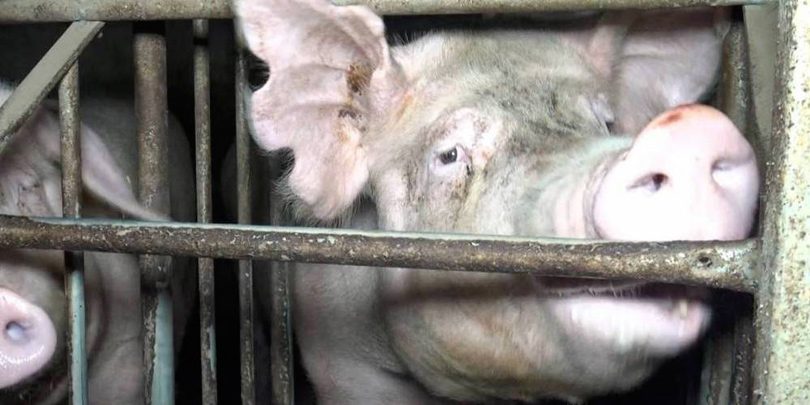L214 denounces a health scandal in a Breton pig farm
A shocking video from the L214 association shows animals forced to live among rotting corpses or bones, on a farm near Quimper.
https://www.youtube.com/watch?v=E_2bjJUonyY
This is a new video-shock on the meat industry. This time, it does not reveal the interior of a slaughterhouse, but that of intensive pig farming, located in Pouldreuzic, in Finistère. These images from the L214 association, that The world was able to view exclusively, reveal, Thursday 16 March, the “deplorable hygienic conditions” of the establishment, “causing intolerable suffering for animals”. The NGO filed a complaint before the Quimper high court for animal abuse – a penalty punishable by six months of imprisonment and 7 500 fine euros – and she launched a petition asking the authorities for the immediate closure of the agricultural business concerned.
The video was produced at the end of January at the EARL in Trégonguen, a medium-sized farm, which breeds and fattens several thousand pigs each year to send them to the slaughterhouse. We see skinny animals there, wounded, sick, even dying. In their pens and huts lie a putrefying body of a sow and several dead piglets.. Pig bones, especially jaw and foot, dot the main hallway.

“Sordid unsanitary conditions”
Wider, the images attest to an absence of cleaning and disinfection of buildings : feces litter the paths and huge cobwebs cover the walls and ceilings, even blocking the corridors providing access to the fattening rooms. Used syringes and expired veterinary products lying on shelves, while the surgical equipment intended for the section of the tails lies on the ground.
“This general unsanitary condition is sordid. The breeder must not check the proper functioning of the breeding on a daily basis., as it should. The animals are left to their own devices, automatically fed, denounces Sébastien Arsac, L214 spokesperson, which advocates the end of all animal exploitation. Ventilation defects lead to respiratory problems for animals, as evidenced by the drugs found in breeding. »
“We also noticed that all the pigs have partially severed tails”, He adds. This practice, used to prevent pigs from devouring the appendages of their fellow pigs, is however not authorized systematically but only when there is evidence of injury.
The association also questions the overpopulation of certain enclosures and their deprivation which prevents pigs from “to exercise their research and manipulation behaviors, what the regulations require ». In the absence of hay, straw or sawdust, the sows only have a simple ball connected to a metal chain. Ultimately, breeding contravenes several European directives and French decrees relating to the protection of pigs and farm animals.

“The risk of transmission of dangers having an impact on animal health, but also on human health, is maximum », warns veterinarian Hélène Gateau, to which the association submitted the images. « How can we leave animals, living beings, at the expense of a visibly overwhelmed breeder ? What are the authorities and veterinary services doing? ? », she asks herself.
Work overload
Contacted by The world, the breeder did not wish to speak, as well as the population protection department of Finistère. These are its veterinary services who had inspected the farm on 25 may 2016. This breeding is a member of the Triskalia cooperative, fifth largest pork producer in Brittany, with its 700 breeders and their 1 700 000 pigs sold per year. The group supplies the French meat giant Bigard, with which it prides itself on having developed quality sectors (Opal Red Label, Blue White Heart, etc.).
“The farm in question is a breeding of 130 farrow-finisher sows on which the breeder, old 29 years, works alone. The latter was installed, in 2013, in the midst of the pig crisis, by buying a breeding farm from a retiring breeder, indicates Triskalia, in a press release. The lack of cleaning of the buildings shown in the images is absolutely not representative of pig farms in France and that this situation is exceptional.. In this breeding, the overload of work led the breeder to concentrate on the care and feeding of the animals to the detriment of the general maintenance of the pigsties. »
The group specifies that it will “immediately put in place an action plan to support the breeder”, in connection with the DDPP, without mentioning closure of the establishment.
Agriculture intensive

For Sébastien Arsac, The clothe “very worrying” of the exploitation of Pouldreuzic “is added to the suffering caused by all industrial farming, which do not meet the physiological needs of animals”. In France, 95 % pigs are raised above ground, in closed buildings, where they do not have access to the outdoors or always to daylight. They move on concrete gratings overlooking pits into which their excrement falls.. Sows are confined in individual stalls, where they can't turn around, at the start of their gestation and throughout maternity. However, they spend part of their lives in group enclosures., since a European directive relating to the protection of pigs 2013. They give birth to nearly thirty piglets per year, then are killed after less than three years of service.
Butcher pigs, them, are fattened in common rooms from weaning until slaughter, 180 days later. Mortality is high : 14 % piglets born alive do not reach this stage, according to the Pork Institute.
Over the years, the number of animals per farm has continued to increase, as they concentrated. With 25 million pigs killed each year, France is the third largest producer in Europe, after Germany and Spain. More than half of the French herd is found in Brittany, a region where intensive agriculture has established itself over the years 1960.
Continuation and end on LeMonde.fr
Brie de Nangis xite Internet of L214


The owner … a month in confinement with his pigs ….and there administrative closure !!!! We have a very good Minister of Agriculture, congratulations to this asshole who doesn't understand anything, can't wait for someone else to take over …I am disgusted